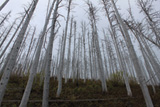CLIMATE & AIRSHED
“Climate is what we expect, weather is what we get.” - Mark Twain, 1835-1910
Climate & Weather
The spectacular Flathead Watershed is located near the earth’s mid-latitude, an area of wide seasonal climatic swings. We experience generally prolonged winters lasting five to seven months, depending on location and elevation. The valley floor sits at an elevation of 3,000 feet (914 m), with the tallest peaks soaring to about 10,000 feet (3,048 m). Winter enhances the expansive landscapes with deeply piled blankets of snow, and brings immeasurable quiet and tranquility to the forests. It is the time of year when we enjoy the appearances of “hoar frost” (Figure 2.12) and “snow ghosts” (Figure 2.13). Hoar frost (also known as radiation frost) occurs when heat loss by objects causes them to become colder than the air that surrounds them, leaving them dusted with graceful, loose white ice crystals. Snow ghosts occur where heavily snow laden trees haunt the forests after long, intense snow storms. People fill the outdoors with activity as they enjoy Nordic and alpine skiing, snow-shoeing, sledding, ice fishing, and sleigh rides. The festively decorated cities and towns offer idyllic backdrops for enjoying the season and the holidays.
 |
 |
 |
| Figure 2.11: Winter. Source: Lynn Ellen Smith |
Figure 2.12: Hoar Frost. Source: Lori Curtis |
Figure 2.13: Snow Ghosts. Source: Lynn Ellen Smith |
Spring and early summer bring melting snow, rain, and a palette of vibrant wildflowers. The curious larch trees begin to sprout their annual vivid light green clusters, and other deciduous trees and bushes develop anxious, color-infused buds. Snow lingers high in the mountains, offering a dramatic backdrop to the emerging multihued landscape. The luxuriously long days of summer beckon us to our favorite warmer weather activities and journeys, including canoeing, kayaking, rafting, fishing, hiking, biking, horseback riding, and golf. Fall shortens the days, but reveals a landscape of unmatched beauty. Cottonwood, aspen, and birch glow in yellows and oranges, and finally larch light the forests with their radiant shade of gold as their needle-like leaves prepare to fall. Bushes and ground covers add their intense yellows, reds, and purples under uninterrupted clear, blue-jay colored skies. Hunters don their own hue of orange as they take to the forests to seek their prey. This full complement of seasons accompanied by a robust palette of color and texture make the Flathead Watershed one of the most desirable locations in the world.
In general, climate considers temperature, precipitation, humidity, wind, atmospheric pressure and other meteorological aspects of a region over extended periods of time. Weather considers these same elements over shorter periods of time. Climate is influenced by the altitude, latitude, terrain, water bodies, and snow and ice cover of a region. The diverse topography and broad range of elevations throughout the Flathead Watershed provides for a wide variety of climatic ranges and requires an equally varied wardrobe for its human inhabitants.
 |
| Figure 2.14: Fall in the Flathead. Source: Lori Curtis |
The climate in the watershed is considered modified maritime, which means it is strongly influenced by moist, Pacific maritime air masses. This moderately temperate maritime air blows inland from the Pacific Ocean producing moderate wet weather, while dry, cold continental air masses blow south from Canada bringing cold dry winters and hot dry summers. The interaction and struggle for dominance between these two systems creates the weather patterns of the Flathead Watershed. The moist air contributes to mild winter temperature, around 20°F (-6.6°C), but also blankets the area with low, gray clouds through much of the winter as well as part of spring and early summer. On average the skies in the Flathead Watershed are cloud-filled 214 days of the year. These extensive periods of time under cloud cover results in a population of people who greatly appreciate the rarer days of abundant sunshine.
The eastern border of the watershed follows the Continental Divide where arctic continental and Pacific maritime conditions meet, sometimes causing dramatic weather fluctuations. Mountain ranges of the Continental Divide typically act as a barrier to the arctic air that flows from Alberta, Canada south along the east side of the Rockies. When those arctic air masses do spill over the Continental Divide and hit moist air, they release snow. The skies will then clear and the temperature can drop to -20° (-28°C) or colder. As Pacific maritime air masses rise to the top of the Continental Divide, they cool and condense then fall as precipitation on the west side. These patterns are noticeable in the vegetation as it changes from the lush forests of the west side to the dry prairies and forests of the east side.
“Summer is delicious, rain is refreshing, wind braces up, snow is exhilarating; there is no such thing as
bad weather, only different kinds of good weather.”
- John Ruskin, 1819 -1900



